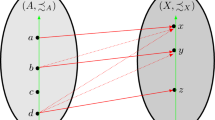Abstract
We propose four fast synchronous distributed message-based algorithms, to identify maximum cardinality sets of edge- and node-disjoint paths, between a source node and a target node in a digraph. Previously, Dinneen et al. presented two algorithms, based on the classical distributed depth-first search (DFS), which run in O(mf) steps, where m is the number of edges and f is the number of disjoint paths. Combining Cidon’s distributed DFS and our new result, Theorem 3, we propose two improved DFS-based algorithms, which run in O(nf) steps, where n is the number of nodes. We also present improved versions of our two breadth-first search (BFS) based algorithms, with the same complexity upperbound, O(nf). Empirically, for a large set of randomly generated digraphs, our DFS-based edge-disjoint algorithm is 39 % faster than Dinneen et al.’s edge-disjoint algorithm and our BFS-based edge-disjoint algorithm is 80 % faster. All these improved algorithms have been inspired and guided by a P system modelling exercise, but are suitable for any distributed implementation.










Similar content being viewed by others
References
Aggarwal A, Kleinberg J, Williamson DP (2000) Node-disjoint paths on the mesh and a new trade-off in VLSI layout. SIAM J Comput 29(4):1321–1333
Bălănescu T, Nicolescu R, Wu H (2011) Asynchronous P systems. Int J Nat Comput Res 2(2):1–18
Cidon I (1988) Yet another distributed depth-first-search algorithm. Inf Process Lett 26:301–305
Cormen TH, Stein C, Rivest RL, Leiserson CE (2009) Introduction to algorithms, 3rd edn. The MIT Press, Cambridge
Dinneen MJ, Kim YB, Nicolescu R (2010a) Edge- and vertex-disjoint paths in P modules. In: Ciobanu G, Koutny M (eds) Workshop on membrane computing and biologically inspired process calculi, pp 117–136
Dinneen MJ, Kim YB, Nicolescu R (2010b) A faster P solution for the Byzantine agreement problem. In: Gheorghe M, Hinze T, Păun G (eds) Conference on membrane computing, Lecture Notes in Computer Science, vol 6501. Springer, Berlin, pp 175–197
Edmonds J, Karp RM (1972) Theoretical improvements in algorithmic efficiency for network flow problems. J ACM 19(2):248–264
Eichmann A, Makinen T, Alitalo K (2005) Neural guidance molecules regulate vascular remodeling and vessel navigation. Genes Dev 19:1013–1021
Ford LR Jr., Fulkerson DR (1956) Maximal flow through a network. Can J Math 8:399–404
Hagberg AA, Schult DA, Swart PJ (2008) Exploring network structure, dynamics, and function using networkX. In: Varoquaux G, Vaught T, Millman J (eds) 7th Python in science conference (SciPy), pp 11–15
Kozen DC (1991) The design and analysis of algorithms. Springer, New York
Lee YO, Reddy AN (2012) Constructing disjoint paths for failure recovery and multipath routing. Comput Netw 56(2):719–730
Lynch NA (1996) Distributed algorithms. Morgan Kaufmann Publishers Inc., San Francisco
Nicolescu R (2011) Parallel and distributed algorithms in P systems. pp 33–42
Nicolescu R, Wu H (2011) BFS solution for disjoint paths in P systems. In: Calude C, Kari J, Petre I, Rozenberg G (eds) Unconventional computation, Lecture Notes in Computer Science, vol 6714. Springer, Berlin, pp 164–176
Nicolescu R, Wu H (2012) New solutions for disjoint paths in P systems. Report CDMTCS-417, Centre for Discrete Mathematics and Theoretical Computer Science, The University of Auckland, Auckland, New Zealand
Păun G (2000) Computing with membranes. J Comput Syst Sci 61(1):108–143
Păun G, Rozenberg G, Salomaa A (2010) The Oxford handbook of membrane computing. Oxford University Press Inc., New York
Seo D, Thottethodi M (2009) Disjoint-path routing: efficient communication for streaming applications. In: IPDPS, IEEE, pp 1–12
Tel G (2000) Introduction to distributed algorithms. Cambridge University Press, Cambridge
Wikipedia (2011) Multipath routing—Wikipedia, the free encyclopedia. http://en.wikipedia.org/wiki/Multipath_routing. Accessed 14 Dec 2011
Acknowledgments
The authors wish to thank Tudor Balanescu, Michael J. Dinneen, Hossam ElGindy, Yun-Bum Kim, John Morris and Sharvin Ragavan, for valuable comments and feedback, and the assistance received via the University of Auckland FRDF Grant 9843/3626216.
Author information
Authors and Affiliations
Corresponding author
Rights and permissions
About this article
Cite this article
Nicolescu, R., Wu, H. New solutions for disjoint paths in P systems. Nat Comput 11, 637–651 (2012). https://doi.org/10.1007/s11047-012-9342-9
Published:
Issue Date:
DOI: https://doi.org/10.1007/s11047-012-9342-9




